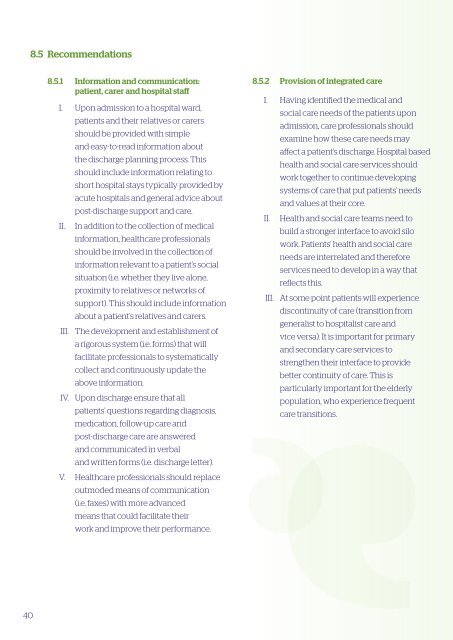Hospital Discharge
3Jzx309Yruj
3Jzx309Yruj
Create successful ePaper yourself
Turn your PDF publications into a flip-book with our unique Google optimized e-Paper software.
8.5<br />
Recommendations<br />
8.5.1 Information and communication:<br />
patient, carer and hospital staff<br />
I. Upon admission to a hospital ward,<br />
II.<br />
III.<br />
IV.<br />
patients and their relatives or carers<br />
should be provided with simple<br />
and easy-to-read information about<br />
the discharge planning process. This<br />
should include information relating to<br />
short hospital stays typically provided by<br />
acute hospitals and general advice about<br />
post-discharge support and care.<br />
In addition to the collection of medical<br />
information, healthcare professionals<br />
should be involved in the collection of<br />
information relevant to a patient’s social<br />
situation (i.e. whether they live alone,<br />
proximity to relatives or networks of<br />
support). This should include information<br />
about a patient’s relatives and carers.<br />
The development and establishment of<br />
a rigorous system (i.e. forms) that will<br />
facilitate professionals to systematically<br />
collect and continuously update the<br />
above information.<br />
Upon discharge ensure that all<br />
patients’ questions regarding diagnosis,<br />
medication, follow-up care and<br />
post-discharge care are answered<br />
and communicated in verbal<br />
and written forms (i.e. discharge letter).<br />
V. Healthcare professionals should replace<br />
outmoded means of communication<br />
(i.e. faxes) with more advanced<br />
means that could facilitate their<br />
work and improve their performance.<br />
8.5.2 Provision of integrated care<br />
I. Having identified the medical and<br />
social care needs of the patients upon<br />
admission, care professionals should<br />
examine how these care needs may<br />
affect a patient’s discharge. <strong>Hospital</strong> based<br />
health and social care services should<br />
work together to continue developing<br />
systems of care that put patients’ needs<br />
and values at their core.<br />
II. Health and social care teams need to<br />
build a stronger interface to avoid silo<br />
work. Patients’ health and social care<br />
needs are interrelated and therefore<br />
services need to develop in a way that<br />
reflects this.<br />
III. At some point patients will experience<br />
discontinuity of care (transition from<br />
generalist to hospitalist care and<br />
vice versa). It is important for primary<br />
and secondary care services to<br />
strengthen their interface to provide<br />
better continuity of care. This is<br />
particularly important for the elderly<br />
population, who experience frequent<br />
care transitions.<br />
40


